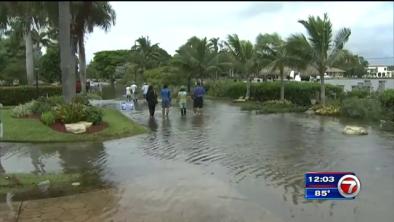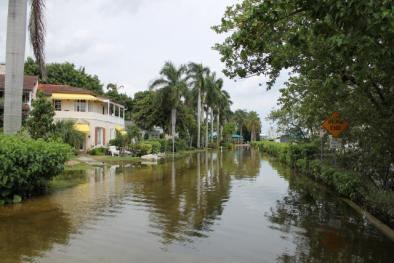How Sea-Level Rise Is Affecting Miami's Low-Income Communities

The water rose quickly. At noon on a brilliantly sunny day here, several blocks from the beach, a lake of salt water suddenly appeared in the street, filtered up from the porous limestone that resides underneath the whole county of Miami-Dade. On the corner of 79th Street and 10th Avenue in the Shorecrest neighborhood, people wandered outside their apartment buildings to stare at the rising water, sloshing through in rain boots to take out their trash.
“It’s been like this for a few days now, rising and then receding and then rising again,” says Jessica Benitez, a resident who moved to Miami from her native Venezuela about a month and a half ago. She says she didn’t know these apartments would flood before she moved into them, and she still doesn’t know how to predict when the water is going to rise. She got home from the store a few days ago to find her street completely flooded, and she tied plastic bags around her feet to get to her door. “[The city] has never told us anything. The water just sits there. It’s like there are no drains, and I don’t understand why,” she says.
She’s not the only one who feels that way. This is just one neighborhood of many in Miami-Dade dealing with the effects of Florida’s King Tide last week, the highest tide of the year. Coastal neighborhoods are hardest hit, but the flooding also reaches farther inland, to less affluent communities. It’s here where the consequences of climate change and sea-level rise could in fact be most grave, says Nicole Hernandez Hammer, a climate researcher with the Union of Concerned Scientists. Middle- and low-income households tend to be less resilient to shocks such as flooding, and they also run the highest risk of being forgotten in the rush to save the millions of dollars in real-estate investments on the waterfront.
“It’s getting worse. When you visit places that weren’t flooding 30 years ago, they’re flooding now,” says Hammer. Today, the Miami area experiences about six of these sunny-day flooding events per year. But the Union of Concerned Scientists projects that by 2045, they’ll be happening 380 times per year. “That’s two times per day in some areas,” she says.
These tidal flooding events are just one of various ways low-income communities are sure to be affected by rising sea levels and climate change in Miami (and in all coastal, low-lying cities). The city government has recently made an effort to include low-income neighborhoods in planning and discussion around climate change. But according to some activists in the county, more needs to be done, and it needs to be done quickly.
Related Content





